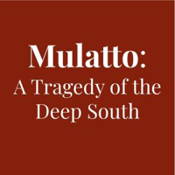
Overview
Synopsis
Langston Hughes’ 1927 poem “Mulatto,” in which a young mulatto man proclaims that he is the son of a white man, provided the foundation for his 1935 play Mulatto: A Tragedy of the Deep South. Plantation owner Colonel Thomas Norwood is a relic of the Old South; even before his wife died, he began an affair with his Black housekeeper, Cora Lewis. He fathered four children with her, but denies that any of them are his children. However, the youngest son Robert is determined to force Norwood to recognize him, his brother William, and his sisters Sallie and Bertha. But Robert’s ambition is not without cost--after an incident in town in which Robert fought with a white woman, Norwood is furious. The two men argue while Cora stands helplessly by, and Robert ultimately kills his father. A lynch mob is formed, and Robert is on the run through the swamps and backroads, Black men and women hide by seeking sanctuary in the church as the mob’s murderous fervor grows. But Cora refuses to leave the plantation house, and makes a hiding spot for her son when he returns. When Robert shows up, the mob close behind, they both know that there is only one way for him to escape their punishment. A heart wrenching indictment of racial injustice and cruelty, Mulatto: A Tragedy of the Deep South recalls the activism of the Harlem Renaissance, Civil Rights movement, and the vitality of art in pursuit of equality.
Show Information
Context
Plot
Characters
| Name | Part Size | Gender | Vocal Part |
|---|---|---|---|
|
Lead |
Male |
Non-singer |
|
|
Lead |
Female |
Non-singer |
|
|
Lead |
Male |
Non-singer |
|
|
Supporting |
Male |
Non-singer |
|
|
Supporting |
Female |
Non-singer |
|
|
Supporting |
Male |
Non-singer |
|
|
Supporting |
Male |
Non-singer |
|
|
Supporting |
Male |
Non-singer |
|
|
Supporting |
Male |
Non-singer |
|
|
Featured |
Male |
Non-singer |
|
|
Featured |
Male |
Silent |
|
|
Featured |
Male |
Non-singer |
|
|
Ensemble |
Male |
Non-singer |
Songs
A song with an asterisk (*) before the title indicates a dance number; a character listed in a song with an asterisk (*) by the character's name indicates that the character exclusively serves as a dancer in this song, which is sung by other characters.
Monologues
Scenes
Key Terms
Sorry! We do not currently have terms for this guide.
Videos
Sorry! We do not currently have videos for this guide.
Quizzes
Themes, Symbols & Motifs
Sorry! We do not currently have learning modules for this guide.
Quote Analysis
Sorry! We do not currently have learning modules for this guide.
